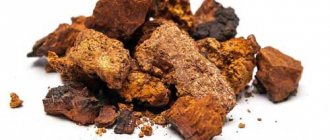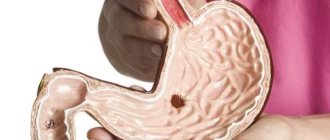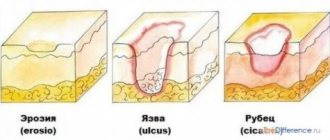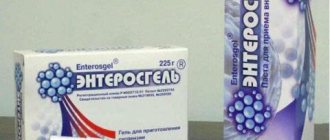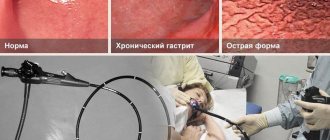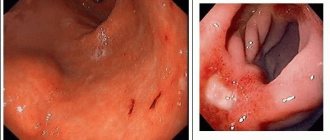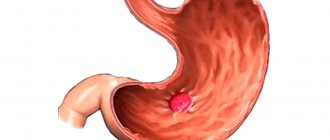De-Nol is a bismuth-based antiulcer medicine that exhibits antibacterial and gastroprotective properties. The selection of a treatment protocol is carried out by a gastroenterologist after a comprehensive diagnosis. De-Nol and Amoxicillin are used in complex treatment regimens for diseases whose pathogens are sensitive to the activity of the active ingredients. Bismuth is a drug compatible with other drugs. It can be taken along with antibiotics and antimicrobial agents for chylactobacteria and stomach ulcers.
Bismuth is also compatible with antibacterial drugs based on azithromycin, clarithromycin, amoxicillin in combination with clavulanic acid.
Rules for combination therapy of gastrointestinal diseases
When treating gastritis and ulcerative lesions of the stomach and duodenum, antibacterial drugs with a wide spectrum of action are prescribed. Sometimes it is necessary to use a combination of several components with antibacterial properties, good compatibility and drug interactions. The following recommendations must be followed:
- Medicines are used in the dose recommended by the doctor. If the medicine does not exhibit the expected therapeutic properties, you should not try to adjust the dosage;
- if medications are ineffective, you should consult your doctor and reconsider your treatment regimen;
- It is necessary to maintain an interval of at least an hour between taking bismuth with other groups of drugs. Simultaneous use is contraindicated. Otherwise, De-Nol may neutralize the activity of the active ingredients of antibiotics;
- De-Nol should not be taken with dairy products, juices, fruit drinks, compotes, or smoothies. Only clean, drinking water is suitable.
You should not try to find medications to eliminate symptoms on your own. This can aggravate the course of the underlying disease and provoke complications.
Why are antibiotics or antimicrobials necessary when treating with De-Nol?
When used independently, it eliminates Helicobacter bacteria in 33% of patients. To achieve a more pronounced therapeutic effect, it is recommended to combine it with antibiotic therapy. Antibiotics are a basic element in the treatment of gastrointestinal diseases caused by exposure to Helicobacter pylori. Your doctor may recommend using:
- macrolides: Clarithromycin, Josamycin, Azithromycin;
- rifamycins: Rifabutin, Rifaximin;
- fluoroquinolones: Tavanica, Ciprofloxacin, Moxifloxacin;
- nitrofurans: Macmiror, Nifuroxazide;
- Metronidazole (Trichopol), Tinidazole.
When eradicating Helicobacter, therapy must be supplemented with bismuth preparations as antimicrobial agents.
The selection of a suitable treatment regimen is carried out depending on the sensitivity of the pathogen to the active component of the drug and individual tolerance of the antibiotic. Therapy should be properly supplemented with antacids before pH testing is performed.
De-Nol and Metronidazole: drug compatibility
Monotherapy with one drug does not give a positive result in the treatment of acid-related gastrointestinal diseases, especially if they are caused by Helicobacter pylori. Not every active enzyme can penetrate under the mucous layer, where Helicobacter pylori forms colonies, multiplies and parasitizes, feeling comfortable in an acidic environment.
Therefore, the disease can only be overcome by using a complex of drugs whose effectiveness has been proven both laboratory and clinically. We will talk about De-Nol and Metronidazole, their properties and pharmacological capabilities.
Description of the drug De-Nol
Belongs to the group of drugs for the treatment of diseases of the gastrointestinal tract. Its effectiveness has been proven by long-term observations of the course of the disease in the treatment regimens in which it was prescribed. Patients note a steady improvement in their condition when taking the medicine in a comprehensive manner:
- with gastritis;
- gastroesophageal reflux;
- peptic ulcers;
- inflammation of the membranes of the duodenum.
It has little effect on acidity. Reception regimen:
- children 6-12 years old: by 1 kg/8 mg per day;
- adults: 1 tablet 4 times or 2 tablets 2 times a day.
Attention! Taking De-Nol has a peculiarity: the tablet must act in an empty stomach for at least 30 minutes. Therefore, take it on an empty stomach with water, and wait half an hour before eating.
Description of the drug Metronidazole
The main feature is the ability to fight simple organisms: Giardia, amoebas, Trichomonas, toxoplasmosis and others. Among them is Helicobacter pylori, the main cause of gastrointestinal diseases.
Has an antimicrobial effect. It is absorbed quickly into the gastrointestinal tract and has its maximum effect within 1-3 hours. Due to its good absorption, it reaches almost all tissues of the body. Prescribed for gastritis and duodenal ulcers.
Take during or after meals, or with milk. There is no need to chew the tablet. Adults: 3 times a day, 500 mg. Children receive prescriptions depending on weight, diagnosis, and condition.
Important! Only the attending physician must accurately dose the dose for a particular child.
Treatment lasts a week. Monitor the patient's condition. In case of obvious side effects, stop taking it and consult a doctor.
Which drug is better
The pharmaceutical activity of De-Nol is aimed at protecting and healing the mucous membrane. Metronidazole fights the pathogen. The use of both drugs in one course of treatment is the right decision, provided that the instructions and dosage are followed.
Depending on whether it is a primary or repeated course of eradication, an antisecretory drug, for example Omez, is also prescribed for these two. It is not recommended to take a gastroprotector and an antiprotozoal drug separately, since a relapse of the disease occurs in 20-30%. Better to take together.
Can I take it at the same time?
The attending physician providing the treatment regimen will emphasize the compatibility of the drugs and be sure to indicate that bismuth-containing De-Nol is taken on an empty stomach, 30 minutes before meals. You can take Metronidazole with meals.
Comparison of drugs De-Nol and Metronidazole
Metronidazole, in addition to its antimicrobial effect, is very stable in acidic gastric secretions. It penetrates the thick layer of the epidermis, finds Helicobacter, clings to its respiratory system, as a result of which it dies.
De-Nol has a bactericidal effect. Forms an enveloping film on the walls of the stomach. After this, the inflamed areas heal faster. That is, one medicine works with the cause of the disease, the other with the effect.
pharmachologic effect
When a De-Nol tablet enters the stomach, bismuth enters into a chemical reaction with hydrochloric acid, forming a precipitate. The resulting film covers the inner walls of the diseased organ. In the craters of ulcers, the drug concentrates more densely, creating a protective protein complex that helps the wound to scar.
Helicobacter pylori resists Metronidazole. Therefore, it is prescribed in combination with amoxicillin, which suppresses resistance. Metronidazole molecules are integrated into the DNA of Helicobacter. After this, the latter cannot breathe, collapses and dies.
Active ingredient
De-Nol consists of Bismuth tripotassium dicitrate. Metronidazole is named after its current formula.
Release form
De-Nol is produced in film-coated tablets. Biconvex, white at the break, with a subtle odor of ammonia. The blister contains 8 units of 120 mg. They produce packs of 7 and 14 blisters. Available without a prescription.
Metronidazole is dispensed in cell and cell-free plates of 10 pieces. Can be purchased in a jar of 20 pcs. Each tablet contains 250 mg of metronidazole. Dispensed by prescription.
Contraindications and side effects
De-Nol is not prescribed in case of individual allergies to components, pregnant and lactating women, children under 6 years of age. Metronidazole should only be taken as prescribed by a doctor, as it has a wider range of restrictions. Treatment of children is based on strictly calculated dosage. It is forbidden:
- pregnant women, in the 1st trimester;
- breastfeeding;
- with liver and kidney failure;
- with individual intolerance;
- if there is a history of leukopenia;
- for ulcerative stomatitis, it is not prescribed to children;
- in combination with amoxicillin is not prescribed until the age of 18.
In the 2nd and 3rd trimester, it is prescribed with caution, according to vital signs. Not prescribed to patients with central nervous system damage.
Important! Drinking alcohol during treatment with Metronidazole is contraindicated.
When taking De-Nol and Metronidazole, a few side symptoms are observed:
- headache, irritability;
- allergic reactions: skin rash, urticaria;
- digestive disorders.
A dose of De-Nol is metabolized primarily in the liver, which is why the stool turns dark. Metranidazole makes urine dark. This is normal when treated with these medications.
conclusions
Drug combinations with De-Nol and Metronidazole increase the percentage of elimination of Helicobacter pylori. This helps speed up the remission of peptic ulcers. A course using 2 or 3 combinations of drugs gives a greater therapeutic effect than treatment with one of them.
Source: https://de-nol.info/sravnenie/metronidazol.html
Basic schemes and features of combining drugs with De-Nol
De-Nol is taken in a course of 30-60 days; longer use can lead to an overdose. Concomitant use of drugs that contain bismuth is contraindicated. Additionally, antibacterial medications are used for a course of up to 10 days. Medicines are used in accordance with the recommendations of the manufacturer and the attending physician. To find out which antibiotic to take De-Nol with, you need to undergo a comprehensive examination.
There are several main treatment regimens using bismuth preparations and antibiotics:
- proton pump inhibitors (Omeprazole 20 mg twice a day) + De-Nol in combination with Amoxicillin and Clarithromycin for 2 weeks;
- PPI (standard dose of Omeprazole or Lansoprazole) + De-Nol (2-4 times a day) + combination of Amoxicillin and Clarithromycin for 14 days;
- if the mucous membrane is atrophied, a combination of Amoxicillin, Clarithromycin and De-Nol is recommended for 2 weeks. If ulcerative defects persist after 2 weeks, De-Nol therapy is extended to 1 month. Tablets are taken in a dose of 120-240 mg 2-4 times a day.
The following options are recommended for patients in older age groups if there are contraindications to full anti-Helicobacter treatment:
- Omeprazole + Amoxicillin (up to 1000 mg twice a day) + De-Nol (2-4 times a day). Duration of therapy – up to 2 weeks;
- De-Nol 120 mg up to 4 times a day for a month. For intense pain impulses, the regimen is supplemented with proton pump inhibitors (Omeprazole or Lansoprazole).
If the patient does not accept the option of antibacterial therapy, bismuth (De-Nol) is prescribed in a standard dose, as well as an aqueous solution of propolis (90 ml 2 times a day before meals) for 2 weeks.
If there is no eradication of Helicobacter, a second line of anti-Helicobacter treatment is recommended. Omeprazole in combination with Amoxicillin (1000 mg twice a day) and Rifaximin + De-Nol 120 mg four times a day for 2 weeks.
Tetracycline antibiotics
De-Nol is incompatible with tetracycline antibiotics. The active component interferes with the absorption of tetracycline in the same way as the intake of food and antacid medications. If necessary, you can maintain an interval of at least 2 hours before and after taking De-Nol.
Penicillins
Penicillins are drugs based on amoxicillin. They enhance the activity of the antimicrobial drug, which includes metronidazole, or Monural. During therapy, adhere to the following recommendations:
- the maximum daily dose for adults is up to 3 grams per day;
- the recommended daily dose is divided into three doses, between which there should be an equal period of time;
- Duration of therapy is up to 10 days.
Bismuth can reduce the absorption of amoxicillin, so De-Nol is used before a meal, and penicillin - 2 hours after the end of the meal.
Macrolides
Macrolides are single-component antibiotics based on azithromycin and clarithromycin. The doctor may suggest using one of the trade names: Bacticap, Klacida, Klabaksa. These are drugs that contain clarithromycin. Representatives of azithromycin include the use of Azitrox, Sumamed, Hemomycin.
What antibiotics are compatible with De-Nol
In therapeutic therapy, antibiotics given in the table are most often used together with bismuth-containing De-Nol:
| Antibiotic | Tradename |
| Amoxicillin | Flemoxin Solutab, Ospamox, Hiconcil |
| Tetracycline | Tetracycline |
| Clarithromycin | Klacid SR, Labax, Clarithromycin-Zentiva, Clarithromycin Pfizer, Fromilid, Fromilid Uno |
De-Nol is not an antibiotic, therefore it successfully complements the second-line quadruple therapy regimen if first-line triple therapy is ineffective:
| 1 line (7-10 days) | Dose, mg | Frequency of intake per day |
| Proton pump inhibitor | Standard | 2 |
| Clarithromycin | 500 | 2 |
| Amoxicillin | 1000 | 2 |
| 2nd line (7-10 days) | Dose, mg | Frequency of intake per day |
| IPP | Standard | 2 |
| Tetracycline | 500 | 4 |
| Metronidazole or amoxicillin | 500/1000 | 2 |
| De-Nol | 120/240 | 4/2 |
Many gastrointestinal diseases associated with Helicobacter are treated:
- stomach and duodenal ulcers;
- gastritis and gastroduodenitis;
- diarrhea (irritable bowel syndrome);
- functional dyspepsia.
It is advisable to use these regimens after resection for gastric cancer, as well as in the patient’s relatives. The success rate of the first scheme is about 75%, provided that the disease is not advanced. The second line, where De-Nol and antibiotics act together, brings recovery in 95% of cases.
Acute and chronic forms of gastrointestinal disorders take much longer to treat and may require additional supportive therapy for a long time. How long treatment will last depends on the patient’s condition, susceptibility to treatment, and the presence of concomitant diseases.
Contraindications to the use of combination therapy
The list of contraindications depends on the medications that are included in the therapy protocol:
- Taking bismuth is contraindicated for pregnant and lactating women, children under 4 years of age, and people with severe liver and kidney dysfunction.
- Clarithromycin is not used for porphyria, during the 1st trimester of pregnancy and breastfeeding, or in the treatment of patients with renal or liver failure.
- An absolute contraindication for all groups of drugs is intolerance to their active substance.
Before using the medicine, you must study the instructions and possible contraindications for its use.
The danger of self-medication for gastrointestinal diseases: the doctor says
Independent selection of medications may not provide the desired therapeutic result. The disease will progress and the likelihood of complications will increase. The symptoms of most gastrointestinal diseases are similar. The selection of a suitable antibiotic therapy regimen, as well as symptomatic drugs, is carried out according to the results of a comprehensive examination.
Uncontrolled use of drugs is fraught with:
- incompatibility of medications;
- low efficiency;
- development of resistance of pathogenic microorganisms to the action of active components of drugs;
- development of adverse reactions;
- incorrect selection of dosage: a low dose is ineffective, a high dose is toxic;
- allergic reactions.
Antibacterial drugs are strictly not intended for self-medication. They can only be prescribed by a doctor.
A few weeks after completion of therapy, follow-up diagnostics are recommended. Patients with complications should be under special medical supervision. People with stomach bleeding and perforation of mucous membranes are at risk. For this category of patients, relapses can be fatal. The sooner people seek quality medical care, the more favorable the prognosis.
Source
Treatment of helicobacteriosis
requires the use of antibiotics that are effective against
Helicobacter Pylori
. It is recommended to use three-component and four-component treatment regimens, which include two antibiotics, gastroprotectors and antisecretory drugs.
Currently, the international standard for the treatment of helicobacteriosis are the following options:
- First line therapy
, which is used when treatment is first attempted. This regimen includes an antisecretory drug in the usual dose 2 times a day, antibiotics Clarithromycin 500 mg 2 times a day, and Amoxicillin 1000 mg 2 times a day. Duration of therapy is 7 – 14 days. - Second-line therapy
, which is used when first-line therapy has failed. This treatment regimen includes an antisecretory drug at the usual dose 2 times a day, Peptobismol 120 mg 2 times a day, and antibiotics Metronidazole 500 mg 3 times a day + Tetracycline 500 mg 4 times a day. The duration of the course of therapy is 7 – 14 days.
The main drugs used for first- and second-line treatment of helicobacteriosis are shown in the table:
| Type of drugs | Pharmacological group of drugs | Name of drugs |
| Antisecretory drugs | I generation H2-histamine receptor blockers | Cimetidine, Histodil, Altramet, Belomet, Ulcometin |
| II generation H2-histamine receptor blockers | Ranitidine, Zantac, Gistac, Zoran, Ranigast | |
| III generation H2-histamine receptor blockers | Famotidine, Ulfamid, Blockacid, Kvamatel, Ulzer, Gastrosidine, Roxatidine, Nazitidine, Mifentidine | |
| Proton pump blockers | Omeprazole, Losek, Omez, Zerotsid, Omezak, Omenat, Ortanol, Lansoprazole, Pantoprazole, Rabenprozole, Pariet, Esomeprazole, Nexium, Lanzap | |
| Gastrocytoprotectors | Bismuth preparations | De-Nol, Tribimol, Ventrisol, Bismol, Peptobismol, Bismofalk 50 mg and 100 mg, bismuth phosphate, bismuth aluminate, bismuth subcarbonate |
| Antibiotics | 5-nitroimidazole derivatives | Metronidazole, Deflamon, Klion, Medazol, Metrogyl, Nidazol, Flagyl, Tinidazole, Tiniba, Fazizhin |
| Semi-synthetic penicillins | Amoxicillin, Augmentin, Gonaform, Grunamox, Ospamox, Ranoxil, Flemoxin Solutab, Hiconcil | |
| Macrolides | Tetracycline, Imex, Clarithromycin, Klacid, Azithromycin, Sumamed, Roxithromycin, Rulide, Renicin | |
| Nitrofurans | Furazolidone | |
| Combination drugs | Combination of antisecretory Ranitidine and anti-Helicobacter bismuth | Pylorid |
In addition to first- and second-line therapy, various regimens consisting of simultaneous administration of three or four drugs can be used. These regimens are used when first- and second-line therapy is ineffective.
Let's consider three-component circuits
that provide cure for helicobacteriosis in at least 90% of cases:
1.
Omeprazole 20 mg 2 times a day, Amoxicillin 500 mg 4 times a day and Clarithromycin 250 mg 4 times a day.
Duration of therapy – 1 week; 2.
Omeprazole 20 mg 2 times a day, Metronidazole 250 mg 4 times a day, Clarithromycin 250 mg 4 times a day.
Duration of therapy – 1 week; 3.
Omeprazole 20 mg 2 times a day, Metronidazole 250 mg 4 times a day, Tetracycline 300 mg 4 times a day.
Duration of therapy – 1 week; 4.
Pilorid 400 mg 2 times a day, Clarithromycin 250 mg 4 times a day, Tinidazole 500 mg 2 times a day.
Duration of therapy – 1 week; 5.
Pilorid 400 mg 2 times a day, Clarithromycin 250 mg 4 times a day, Amoxicillin 500 mg 4 times a day.
Duration of therapy – 1 – 2 weeks; 6.
Pilorid 400 mg 2 times a day, Tetracycline 300 mg 4 times a day, Metronidazole 250 mg 4 times a day.
Duration of therapy – 1 – 2 weeks; 7.
Omeprazole 20 mg 4 times a day, Clarithromycin 500 mg 2 times a day, Amoxicillin 1000 mg 2 times a day.
The duration of taking antibiotics is 1 week, and Omeprazole is 3 – 4 weeks; 8.
Omeprazole 20 mg 2 times a day, Clarithromycin 250 mg 4 times a day, Metronidazole 250 mg 4 times a day. The duration of taking antibiotics is 2 weeks, and Omeprazole is 3 - 4 weeks.
LiveInternetLiveInternet
Quote from Velvet_Hat
Read in full In your quotation book or community!
Treatment of gastroduodenitis
To my readers! After food poisoning, I developed gastroduodenitis. I ran to doctors, but no one offered anything intelligible. During this time, I found a lot of useful information on the Internet. I publish schemes for Helicobacter pylori therapy, protection of the gastric mucosa, treatment of chronic gastrointestinal tract with autonomic dysfunction, and gastrointestinal motility disorders. Just remember, medications are no joke. What you will read in my diary
MUST REQUIRE CONSULTATION WITH A GASTROENTEROLOGIST
I wish everyone good health!
Your Velvet_Hat
1. Diet. 2. To eliminate Helicobacter pylori infection, the following regimens are used (strictly as prescribed by a doctor):
- De-nol 4-6 weeks. + metronidazole 10-14 days. + tetracycline antibiotic 7-10 days.
- Omeprazole + clarithromycin or amoxicillin + metronidazole , course duration 1 week.
- Metronidazole 10-14 days + amoxicillin 10 days + ranitidine 0.15 g before breakfast and before bedtime 10-14 days.
- Omeprazole + de-nol + amoxicillin or clarithromycin + metronidazole, 10-day course of treatment.
Anti-Helicobacter therapy.
World experience in the treatment of helicobacteriosis has shown the ineffectiveness of monotherapy, therefore, currently double, triple and quadruple therapy regimens are used to eradicate Hp.
a) Triple scheme: includes colloidal bismuth subcitrate (CBS) in the form of de-nol, tribimol or ventrisol, 1 tablet each. (120 mg) 3-4 times a day 30 minutes before meals + antibiotic (AB): amoxicillin at the rate of 50 mg/kg per day in 3 doses or clarithromycin 15 mg/kg or sumamed 10 mg/kg per day (then 5 mg /kg) + metronidazole (Trichopolum) at the rate of 15 mg/kg per day in 3 divided doses after meals.
Course duration 2 weeks. This scheme is preferable for Hp-associated gastroduodenitis with normal secretory function.
b) Double regimen: includes an H+K+ATPase blocker (omeprazole, lanceprazole, pantoprazole) once at night at the rate of 1–2 mg/kg, usually 1 caps. + antibiotic (AB): amoxicillin, clarithromycin or sumamed. Course duration 2 weeks.
The regimen is indicated for Hp-associated gastroduodenitis with increased secretory function; it gives fewer adverse reactions than the triple regimen, since it does not contain trichopolum.
c) Quadruple regimen: includes omeprazole + SWR + AB + trichopolum in the doses indicated above, the peculiarity of this regimen is the shorter duration of the course - 7 days, due to which it gives fewer adverse reactions.
The scheme is indicated for erosive Hp-associated gastroduodenitis with increased secretory function. According to the Maastricht Agreement (1996), a seven-day course of a combination of pylorid (ranitidine-bismuth citrate), clarithromycin and metronidazole is recommended for the eradication of chelinobacteriosis. Evaluation of the effectiveness of therapy is carried out no earlier than 4 weeks after its completion, only then can we talk about successful eradication of HP.
3. To eliminate symptoms (belching, heartburn) use “Phosphalugel”, “Motilium”
4. Drug therapy during an exacerbation is aimed at correcting secretory disorders, eradicating HP, improving metabolic processes in the mucous membrane, eliminating dysmotility, and normalizing neurovegetative status. Correction of gastric hypersecretion. In most children with chronic gastroduodenitis, the secretory function of the stomach is increased; in order to correct it, you can use: - Non-absorbable antacids that neutralize hydrochloric acid, adsorb pepsins and bile acids: almagel, gelusil-varnish, gastal, magaldrate, etc. The drug is in the form gel (1 dosage spoon) or crushed tablet (can be sucked) is taken 3-4 times a day, an hour after meals and at night, the course is 3-4 weeks.
— H2-histamine blockers (ranitidine, famotidine, nizatidine, roxatidine), which are taken 1–2 times a day (morning and at night) – 1 tablet for 1–2 weeks, have a powerful antisecretory effect
— The most powerful antisecretory effect is exerted by inhibitors of the acid pump H+K+ATPase) - omeprazole, pantoprazole, lanceprazole.
These drugs are taken once a day (in the morning or at night) for 2 weeks.
- In the presence of concomitant signs of VSD, an increase in predominantly basal gastric secretion, the prescription of anticholinergics is indicated, preferably selective, acting only on M1-cholinergic receptors of the gastrointestinal tract - gastrocepin, telenzepine, -1 tablet 2 times a day 30 minutes before meals for 2-3 weeks.
5. Correction of motor disorders.
Pain syndrome during exacerbation of gastroduodenitis is often caused by concomitant spasm and increased peristalsis of the stomach.
Against this background, the prescription of smooth muscle antispasmodics is shown:
no-spa, papaverine, halidor – 1 tablet 3 times a day,
anticholinergics with a predominant antispasmodic effect: - platifillin, buscopan, metacin, belloid - 1 tablet 3 times before meals.
6. In the presence of pathological reflux (duodeno-gastric, gastro-esophageal), prokinetics are indicated: cerucal, motilium 1 mg/kg per day in 3 divided doses 30 minutes before meals; cisapride/prepulsid, coordinax (0.4–0.5 mg/kg per day 30 minutes before meals). Course 10–14 days.
7. Improving metabolic processes in the mucous membrane.
In the presence of atrophic changes, especially in the area of the main gastric glands, the administration of vitamins B1, B2, B3, B5, B6, B12, folic acid, A and E is indicated. Multivitamin complexes with microelements are usually prescribed (unicap, supradin, oligovit, complivit, etc. .d.).
Membrane stabilizing drugs are indicated:
Essentiale-forte, lipostabil 1 capsule 3 times after meals; biostimulants of metabolic processes: carnitine chloride 20%, 20–40 drops. 3 times, Mildronate 1 tablet. 3 times, betaine, apilak, 40% propolis solution (1 capsule per year of life, 2-3 times a day before meals in milk), mumiyo (0.2 g in milk 2 times a day). The course of treatment usually lasts about a month.
8. For symptoms of vegetative-vascular dystonia and neurosis accompanying CGD, sedative therapy (decoction of motherwort or valerian, belloid, bellataminal, minor tranquilizers) or adaptogens (ginseng, eleutherococcus, Rhodiola rosea, golden root, etc.) may be indicated.
9. During the period of subremission and remission of CGD, herbal medicine can be carried out, in which mixtures are formed from anti-inflammatory (chamomile, St. John's wort, calendula), astringent (calamus root, licorice, oak bark), stimulating (rose hips, yarrow herb, plantain leaves) herbs, brewed 1 : 10, drink a glass 15–20 minutes before meals 3 times a day for 3–4 weeks.
10. Sanatorium-resort treatment is carried out in local balneological sanatoriums or at the resorts of the Caucasian Mineral Waters.
Mineral waters of low mineralization are recommended: Slavyanovskaya, Smirnovskaya, Essentuki No. 4, Arzni, etc. at the rate of 3 ml/kg 3 times a day,
with increased secretory function - 1–1.5 hours before meals, warm,
with reduced secretory function - 15–20 minutes before meals,
with normal secretion, water at room temperature - 45 minutes before meals.
The course of treatment is 3–4 weeks. Mineral baths (sulfur, radon, carbon dioxide), mud on the epigastric region, and exercise therapy are also prescribed.
Pharmacological properties, forms, indications and limitations
What is better Metronidazole or De-Nol? De-Nol and Metronidazole have different pharmacological groups, indications and limitations. De-Nol is an astringent antiseptic that promotes healing and coating of the gastric mucosa. Metronidazole is an antimicrobial drug.
To compare De-Nol with the drug Metronidazole, you need to study their pharmacological effects, forms, indications and limitations for use.
Comparative characteristics of medicines.
Bismuth tripotassium dicitrate
Tablet forms (120 mg).
Ampoules (1 ml - 5 mg), tabulated forms (250 mg, 500 mg), suppositories (125 mg, 250 mg, 500 mg), vaginal gel (10 g), cream and gel for external use (10 g).
Kidney pathologies, gestation period, breastfeeding, intolerance to drug components, children under 4 years of age.
Intolerance to the components of the drug, damage to brain tissue, low white blood cell count, liver dysfunction, breastfeeding.
Metronidazole kills pathogenic organisms from the group of anaerobes and aerobes, fights Helicobacter pylori, lamblia and other microbes. De-Nol reduces the proliferation of Helicobacter pylori, coats the intestinal walls, and restores its cells.
Rules for the use of medicines
Metronidazole and De-Nol are used both separately and together.
Rules for taking De-Nol:
- adults and children over 12 years of age - 1 tablet form 4 times a day;
- child 8-12 years of age - 1 tablet twice a day;
- children 4-8 years of age - 8 mg per 1 kg of weight.
De-Nol tablets should be taken half an hour before meals. Course therapy lasts 1-2 months.
Metronidazole in the presence of Helicobacter pylori is taken according to the following regimen: 500 mg three times a day. Metronidazole with De-Nol is often prescribed. Metronidazole should be taken for 3-5 days. If necessary, the doctor may extend the treatment. Amoxicillin or another antibiotic is added to these medications. This complex therapy is excellent for gastritis. You can take the drug De-Nol with Metronidazole as part of a complex treatment with antibacterial drugs for stomach and duodenal ulcers.
Description of the drug De-Nol
Belongs to the group of drugs for the treatment of diseases of the gastrointestinal tract. Its effectiveness has been proven by long-term observations of the course of the disease in the treatment regimens in which it was prescribed. Patients note a steady improvement in their condition when taking the medicine in a comprehensive manner:
- with gastritis;
- gastroesophageal reflux;
- peptic ulcers;
- inflammation of the membranes of the duodenum.
It has little effect on acidity. Reception regimen:
- children 6-12 years old: by 1 kg/8 mg per day;
- adults: 1 tablet 4 times or 2 tablets 2 times a day.
Attention! Taking De-Nol has a peculiarity: the tablet must act in an empty stomach for at least 30 minutes. Therefore, take it on an empty stomach with water, and wait half an hour before eating.
Comparison of drugs
Helicobacter pylori is a bacterium that can survive in the acidic environment of the stomach. For the discovery of the connection between its presence and the development of gastritis, gastric and duodenal ulcers, the authors of the study were even awarded the 2005 Nobel Prize in medicine. And if the cause of the disease is a bacterium, then it must be treated with antibacterial drugs. Taking Metronidazole and Amoxicillin together is considered the first line of therapy and is widely used in modern gastroenterology.
Indications
The combination of Metronidazole and Amoxicillin is used in the treatment of all diseases of the stomach and duodenum associated with Chalicobacter pylori. The drugs are used not only together, but also exclusively in combination with proton pump inhibitors that reduce gastric acidity (Omeprazole, Rabeprazole, etc.). In addition, Clarithromycin, another antibiotic, is often used instead of Metronidazole or Amoxicillin. Most often, all these drugs are used as part of the so-called. quadruple therapy (treatment with four drugs) for Helicobacter-associated diseases, which is as follows: Omeprazole + Clarithromycin + Amoxicillin + Metronidazole.
Thus, medications should be taken when:
- Stomach ulcer;
- Duodenal ulcer;
- Gastritis caused by Helicobacter.
Contraindications
In addition to its incredibly strong antibacterial effect, this combination of drugs has contraindications:
- Drug intolerance;
- Liver dysfunction;
- Renal dysfunction;
- Age up to 12 years;
- Pregnancy;
- Alcoholism;
- Treatment of oncological diseases;
- Treatment of tuberculosis.
Side effects
The combination of drugs can cause:
- Allergic reactions;
- Severe digestive disorders;
- Heartburn;
- Intestinal dysbiosis;
- Dysbacteriosis of the female genital organs;
- Liver dysfunction.
De-Nol - antiulcer agent
The drug De-Nol is a modern antiseptic with pronounced bactericidal activity. Belongs to the group of gastroprotectors that protect the mucous membrane and layers of muscle tissue of the intestines and stomach, neutralize the aggressive environment and increase the resistance of the mucous membrane of the digestive system to the effects of hydrochloric and bile acids.
The peculiarity of this drug is that it has an effect not only in the stomach cavity, but also in all parts of the intestine. This is very important, since the small and large intestines have multiple bends in which food debris can accumulate. In such pockets, pathogenic microorganisms actively develop that can cause diseases of the stomach and intestines. However, De-Nol can disrupt the process of peptic ulcer disease and prevent its development.
In addition, in the stomach, De-Nol forms a colloidal solution that gently envelops the gastric mucosa and protects it from the destructive effects of gastric juice components.
Another important advantage of De-Nol is its powerful antimicrobial effect. Its components destroy the cell membranes of bacterial cells. And thanks to the bismuth compound, they prevent the formation of strains of microorganisms resistant to the drug. This significantly reduces the likelihood of developing gastritis.
Release forms and price
Prices for Metronidazole may vary depending on its manufacturer:
- Pills:
- 250 mg, 20 pcs. – 15 – 25 rubles;
- 250 mg, 24 pcs. – 80 – 100 rub;
- 250 mg, 40 pcs. – 140 – 150 rub;
- 500 mg, 10 pcs. – 180 – 190 rub;
- 500 mg, 20 pcs. – 70 – 90 rub;
It should be noted that there are other drugs with metronidazole as an active ingredient, but under a different name.
Amoxicillin is also produced by different companies, which is why its cost can also fluctuate (for convenience, prices for tablets and capsules are given in terms of 20 pcs.):
- Capsules/tablets (calculated for 20 pcs.):
- 250 mg – 75 RUR;
- 500 mg – 65 – 200 rub;
- 1000 mg – 275 rub.
The active ingredient amoxicillin is also found in a large number of drugs under different names.
Metronidazole and Amoxicillin at the same time
The first reviews of the combination of these drugs appeared immediately after they began treating peptic ulcers. Today, quadruple therapy (treatment with four drugs) is one of the most effective and powerful ways to get rid of Helicobacter pylori infection. The use of Amoxicillin and Metronidazole in combination with other drugs allows you to avoid disabling operations that remove most of the stomach along with the ulcer. One of the main disadvantages of this combination is the subsequent need to take probiotics or treatment in gynecology for dysbiosis.
